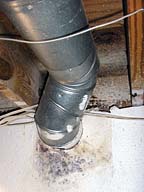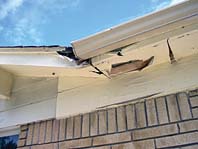
According to Nehasil, the family had been in the home less than three years when they were advised by their doctor to leave the home in November of 2001 due to problems related to the presence of Stachybotrys, a type of mold. Nehasil noted she and her husband Craig, as well as their three children, developed symptoms including frequent sinus infections, chronic headaches, and shortness of breath. The children sometimes woke up with bloody noses, Nehasil reported, and her six-month-old son had trouble breathing.
The family asserts that the root of the problem was moisture caused by a leaky roof and a poorly ventilated attic, as well as a damp basement that lacked adequate sealant protection and was plagued by water draining from the surrounding area, which was improperly graded.
The Nehasils are involved in legal proceedings against the home's former owners, whom they claim sold the home to them without disclosing the water problems. The Nehasils allege the former owners covered up the problems, in part by painting over the mold and water stains. The Nehasils do not plan to return to the home and said they will forfeit it to their lending institution.
They said the lending institution will ultimately decide the fate of the home, but the cost of remediation and correction to structural problems could lead to the demolition of the home.
The News was given the opportunity to tour the home with Nehasil and Eric Haemelinck, an environmental project engineer with Sanit-Air of Troy, Mich., the company that conducted the investigation of the premises as part of the litigation process.

Wet And Wetter
The conditions of the home had apparently worsened in the 2-1/2 years since the family had moved out. It had only been visited on a few different occasions in the interim. Rotted wood, chipped paint, and a rust-stained vent stack were obvious from outside of the home.Inside the attic, Haemelinck pointed out some obvious flaws, including insulation that was installed upside down and the lack of a vapor barrier.
"The attic couldn't breath at all," he said, noting there were no soffits in the attic.
Problems were evident around the foundation as well, said Haemelinck. "There has been a lot of intrusion around the basement of the home," he said. "The driveway area has been heavily caulked, and panels were added to the walls of the basement to hide the problem."
Caulking ran the full width of the driveway to the outside fence. A gutter drain spout was angled toward the foundation. "The grade around the homes in this neighborhood is terrible," Nehasil said. "Neighbors have had problems with their homes, too."

Inside the basement, rust was visible on the galvanized ductwork and on the plenums. Rust also covered parts of the furnace.
"If you see galvanized ductwork that is rusted, you know that the water problem has been going on for a long time," Haemelinck said. "I doubt that there was ever much maintenance done on the system."
Nehasil said that her husband had installed new grilles for the supply and return vents, but after a time rust began showing up on the grilles. Craig Nehasil had noticed areas in the upstairs bathroom that were water damaged, and took it upon himself to tear out the drywall and clean the area, not knowing that he was exposing himself to the mold.
"My Mother's Day present one year was a dumpster," joked Nehasil. "And I was fine with that because he was trying hard to fix the house. At the time we knew little about mold, especially the fact that it could hurt you. I was forever bleaching and it always had the awful smell. Craig has inhaled so much of it that he couldn't even smell it anymore."

Microscopic spores can become airborne during the drying process. Even if the mold is cleaned from one area, said Haemelinek, it can show up on something else, be it a wall, ceiling, or in one instance in the Nehasil home, the back of the stereo speakers.
"It's kind of like a dandelion," said Haemelinck. "It will send out seeds to propagate the next season when conditions are correct again."
To make matters worse, the Nehasils often ran their attic fan, which pulled air out of the damp basement and put the home under a negative pressure, exacerbating the problem.
"The spores were moved all over the house," Haemelinck said.
Nehasil added that a neighbor tried to help out by letting them use his dehumidifier, which made the family cognizant of just how bad the problem was. "That dehumidifier was huge and we were emptying it out every other day," she said.

Searching For Help
Just the sight of the problems was enough to drive people away."Every time we had someone come out to look at the problem, they would walk away," Nehasil said. "Nobody wanted to be involved. Heating and cooling contractors, roofers, even electricians would look at the house and walk away. They all knew something major was wrong.
"Even those who gave us estimates couldn't guarantee their work. One company was going to tear up the slab and the basement - a $50,000 to $60,000 job - and he couldn't even guarantee that it would solve our water problem.
"One restoration company we called said they wouldn't come in our house until it was determined what was wrong."
Nehasil began educating herself about mold by using the Internet as a resource. She also received information from Sanit-Air, the company recommended to family members by the attorney representing them in the nondisclosure lawsuit.

Sanit-Air offers "environmental compliance solutions" (ECS) to its clients, and its programs include duct cleaning, mold abatement, air sampling, and air sanitizing. Connie Morbach heads the ECS division of Sanit-Air. Thomas Morbach is the company's president and founder.
"We do a lot of continuing education for contractors, property managers, attorneys, etc.," said Haemelinck.
"All of the samples we collect go out to an independent lab for analysis. The lab has no vested interest in our samples. The Internet is a great resource because you can go to the EPA Web site and look up the guidelines for mold remediation. If you hire a consultant who doesn't follow these guidelines, you need to move on to someone who does."
For more information, contact Sanit-Air at 248-616-0477 or visit www.sanit-air.com.
Publication date: 06/21/2004



